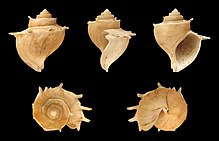Tiphobia horei
| Tiphobia horei | |
|---|---|

| |
| Five views of a shell of Tiphobia horei | |
| Scientific classification | |
| Kingdom: | |
| Phylum: | |
| Class: | |
| (unranked): | |
| Superfamily: | |
| Family: | |
| Subfamily: | |
| Tribe: | |
| Genus: | Tiphobia E. A. Smith, 1880[2]
|
| Species: | T. horei
|
| Binomial name | |
| Tiphobia horei E. A. Smith, 1880[3]
| |
| Synonyms | |
|
Melania Horei E. A. Smith, 1880[3] | |
Tiphobia horei is a species of freshwater snail with an operculum, an aquatic gastropod mollusk in the family Paludomidae.
Tiphobia horei is the only species in the genus Tiphobia.[4] Tiphobia is the type genus of the tribe Tiphobiini.[5]
The specific name horei is in honor of Reverend Edward Coode Hore (1848-1912) from the UK.[3]
Distribution
Tiphobia horei is endemic to Lake Tanganyika.[1] It is found in Burundi, the Democratic Republic of the Congo, Tanzania, and Zambia.[1] The type locality is Lake Tanganyika at Ujiji.[4]
Description
Tiphobia horei has a large shell with spines, so it is easily to determine.[4]
The width of the shell is 26 mm.[4] The height of the shell is 36 mm.[4]
Ecology
The natural habitat for this species is freshwater lakes.[1] Tiphobia horei lives in depths of 0-150 m on mud bottoms, mainly in river estuaries.
This snail was given Endangered species status in 1996, but in 2006 this was revised to Least Concern.[1] Its survival is threatened mainly by sedimentation, dredging and shell trading.
-
Tiphobia horei Smith, 1880. Museum specimen.
-
Tiphobia horei Smith, 1880. Museum specimens.
References
- ^ a b c d e Nicayenzi F., Ngereza C. & Lange C. N. (2004). Tiphobia horei. 2006 IUCN Red List of Threatened Species. Downloaded on 7 August 2007.
- ^ Smith E. A. (1880). "On the shells of Lake Tanganyika and of the neighbourhood of Ujiji, central Africa". Proceedings of the Zoological Society of London 1880: 344-352. page 348, Plate 31, figure 6-6b.
- ^ a b c Smith E. A. (1880). "Diagnoses of new shells from Lake Tanganyika and East Africa". Annals and Magazine of Natural History (5)6: 425-430. page 427.
- ^ a b c d e Brown D. S. (1994). Freshwater Snails of Africa and their Medical Importance. Taylor & Francis. ISBN 0-7484-0026-5.
- ^ Bouchet, Philippe; Rocroi, Jean-Pierre; Frýda, Jiri; Hausdorf, Bernard; Ponder, Winston; Valdés, Ángel & Warén, Anders (2005). "Classification and nomenclator of gastropod families". Malacologia. 47 (1–2). Hackenheim, Germany: ConchBooks: 1–397. ISBN 3-925919-72-4. ISSN 0076-2997.
External links
- Moore J. E. (1898). "The mollusks of the Great African lakes. 2. The anatomy of the Typhobias, with a description of a new genus (Batanalia) (sic)". Quarterly Journal of Microscopical Science 41: 181-204. Plate 11-14.



